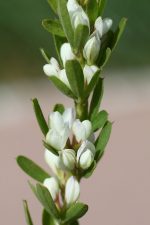 Also called Chinese bush clover, this semi-woody perennial is a member of the pea family, Fabaceae, that also lupines, mimosa, and alfalfa. It is native to China, Korea, Japan, Formosa, and the Himalayas but was introduced into North Carolina from Japan in 1896 and was planted for erosion control, mine reclamation, and wildlife habitat. Plants have formed dense stands in new and old forest openings, dry upland woodlands, moist savannas, and old fields and has become invasive in New England, Michigan, and Nebraska, south to Florida and Texas. Growing 3-6′ tall from a woody rootcrown with a taproot, the plant has one to many slender branching gray-green stems bearing leaves composed of three narrowly oblong leaflets .4 to .8″ long. Each leaflet is green above with light colored hairs below and is carried on a hairy petiole. From July to September, 1-4 pea like white flowers with a purple throat appear in the upper leaf axils. Each flower is .1 to .3 ” long and has a calyx with 5 long teeth that often turn purplish green. The fruit is a single seeded green pod that turns tan when mature. The genus name, Lespedeza, honors the Spanish governor of Florida, Vincente Manuel de Cespedes c 1790, but a spelling mistake obscures the intent. The specific epithet, cuneata, is the Latin word meaning pointed like a wedge and refers to the shape of the leaflets.
Also called Chinese bush clover, this semi-woody perennial is a member of the pea family, Fabaceae, that also lupines, mimosa, and alfalfa. It is native to China, Korea, Japan, Formosa, and the Himalayas but was introduced into North Carolina from Japan in 1896 and was planted for erosion control, mine reclamation, and wildlife habitat. Plants have formed dense stands in new and old forest openings, dry upland woodlands, moist savannas, and old fields and has become invasive in New England, Michigan, and Nebraska, south to Florida and Texas. Growing 3-6′ tall from a woody rootcrown with a taproot, the plant has one to many slender branching gray-green stems bearing leaves composed of three narrowly oblong leaflets .4 to .8″ long. Each leaflet is green above with light colored hairs below and is carried on a hairy petiole. From July to September, 1-4 pea like white flowers with a purple throat appear in the upper leaf axils. Each flower is .1 to .3 ” long and has a calyx with 5 long teeth that often turn purplish green. The fruit is a single seeded green pod that turns tan when mature. The genus name, Lespedeza, honors the Spanish governor of Florida, Vincente Manuel de Cespedes c 1790, but a spelling mistake obscures the intent. The specific epithet, cuneata, is the Latin word meaning pointed like a wedge and refers to the shape of the leaflets.
Type: Semi-woody perennial
Bloom: One to four white flowers with purple throat from July to September
Size: 3-6′ H
Light:Full sun
Soil: Average, medium moist to dry, well-drained; tolerates lean soil
Hardiness: Zones 6-8
Care: Low maintenance
Pests and Diseases: None of significance
Propagation: Seed, half-ripe cuttings
Companion Plants: Not applicable
Photo Credit: Dalgial, Wikimedia